
Browse an alphabetical list of photographs. These historical images portray people, places, and events before, during, and after World War II and the Holocaust.
<< Previous | Displaying results 1876-1900 of 2641 for "Photo" | Next >>
A Hungarian Jewish youth identifies the body of his father, who was shot by the SS during a death march from Flossenbürg. Members of the US military prepare the victims' burial. Neunburg, Germany, April 25, 1945.
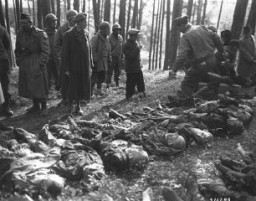
Fifteen-year-old Maria Dolezalova is sworn in as a prosecution witness at the RuSHA Trial. Dolezalova was among the children kidnapped by German forces after they destroyed the town of Lidice, Czechoslovakia. Nuremberg, October 30, 1947.
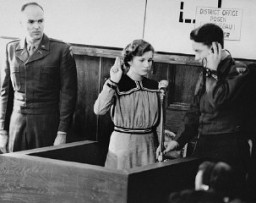
US Major Frank B. Wallis (standing center), a member of the trial legal staff, presents the prosecution's case to the International Military Tribunal at Nuremberg. A chart (top left) shows where the defendants (bottom left) fit into the organizational scheme of the Nazi Party. At right are lawyers for the four prosecuting countries. Nuremberg, Germany, November 22, 1945. The trials of leading German officials before the International Military Tribunal are the best known of the postwar war crimes trials.…
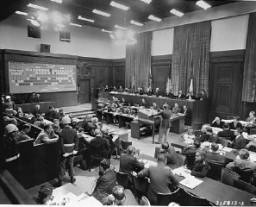
President Franklin D. Roosevelt in the Oval office at the White House, shortly before delivering a speech accepting the Democratic Party's presidential nomination. Washington, DC, United States, July 24, 1940.
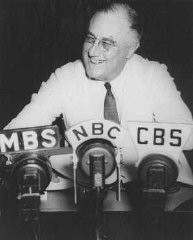
People gather in the street to read a special edition of the Nurnberger newspaper reporting the sentences handed down by the International Military Tribunal. Nuremberg, Germany, October 1, 1946.
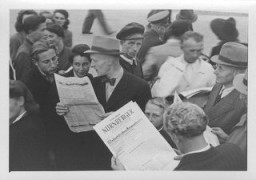
Shlamke and Shanke Minuskin pose with their baby son, Henikel, in the garden of their home. Zhetel, Poland, 1938.
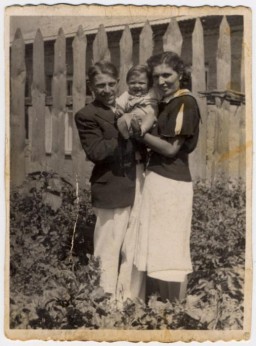
Reine (seated in window) and Yishua Ghozlan (standing) were married in Constantine, Algeria, on March 29, 1932. They are pictured here with two of their parents. The couple experienced antisemitism in the prewar years, and in 1933 Reine and Yishua survived a deadly pogrom by hiding with French Christian friends. After the start of World War II, Yishua was thrown out of his position in the post office. Reine, Yishua, and their children were evicted from their apartment.
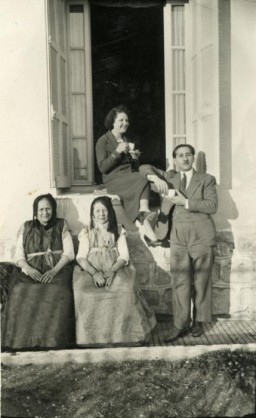
The Kracowski family was living in Bialystok when German Order Police Battalion 309 killed 2,000-3,000 Jews on June 27, 1941. Dr. Samuel Kracowski was among the hundreds of Jews locked in the Great Synagogue and burned alive. After the Germans ordered the establishment of a ghetto in Bialystok, Samuel's wife, Esther, and children, Ewa and Julek, were given a room in the ghetto clinic. Photo dated September 1, 1935. Samuel and Esther are seated in the center, with Julek seated in the front row on the…

Prewar family photograph of Berta and Inge Engelhard holding pigeons in a public square in Munich. Photograph taken in Munich, Germany, 1937. Following increased anti-Jewish measures, Berta and brother Theo (not pictured here) left Germany on a Kindertransport in January 1939. Inge followed on a different transport a few months later. While the siblings were eventually housed together in England, they faced many challenges during the war including the pain of separation from their parents. Parents Moshe…
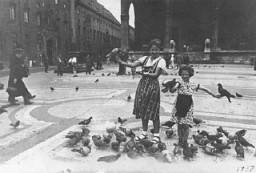
Lucie Lind shopping in an open-air market in Lwów, Poland, sometime in the 1930s. Lucie was born into an affluent Jewish family on January 23, 1909. At the time, Lwów (Lemberg) was part of the Austro-Hungarian Empire. Lucie was educated in Vienna. Before World War II, she was a housewife. Her first husband was a well-known artist throughout Europe. The couple’s daughter was born in 1936. Lucie’s fashionable clothes, hat, and gloves are typical for middle or upper class women living in Poland at the…
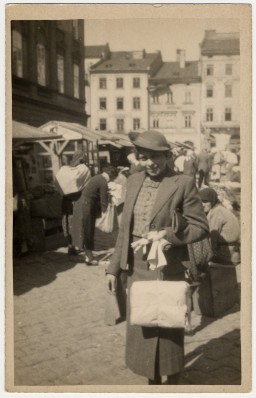
Terese Cohen, a Tunisian Jewish women, poses with her two children, Nadia and Marcel. Immediately after the Allied landings in Algeria and Morocco, the Germans occupied Tunisia. After the occupation, an SS officer came to the Cohen's house and confiscated everything leaving only the table and chairs for the Germans to use. They gave the family 24 hours to pack and leave and then expropriated the home to use as a barracks for soldiers.
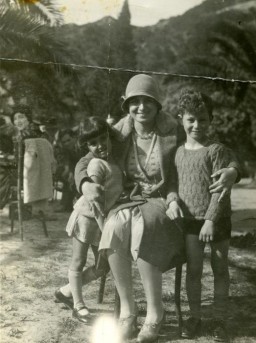
Prewar photo of Ala Gertner. Bedzin, Poland, 1930s. After being deported to Auschwitz, Ala Gertner took fate into her own hands. Upon arrival, she was assigned to forced labor at a nearby armaments factory. After learning that they were going to be killed, Gertner, along with fellow female prisoners, began smuggling gunpowder and explosives from the factory with plans to destroy one of the crematoriums. During the uprising in October 1944, the prisoners killed three guards. They also set fire to…
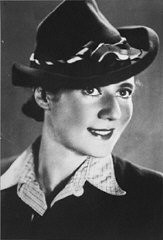
A prewar photograph of Basia and Moshe Golden (Gordon) taken ca. 1922–1925 in Swieciany, Poland (now Lithuania). Basia, along with two of their four children, Boruch and Teyva, were shot at the Ponary killing site by SS men and their Lithuanian collaborators in September 1943. Moshe died in the Klooga concentration camp. Two of their children survived, Niusia and Rwya. This photograph was saved by Niusia (now Anna Nodel) while she was in hiding.
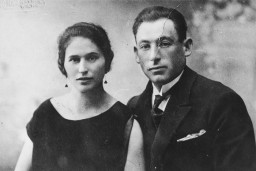
Dorrith was born in Kassel, Germany, in December 1938. Her parents were Hans and Trudi Oppenheim. Following increased anti-Jewish measures, Dorrith was among the children sent on Kindertransports to find refuge in the United Kingdom. She left Germany on July 24, 1939. She never saw her parents again. They were deported to Auschwitz, where they perished in October 1944.
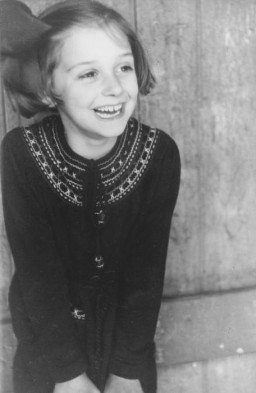
Prewar portrait of Golda Tenin with her daughter Paulina, 1935. The Tenin family was living in the Ukrainian city of Odesa when it was occupied by Romania, an ally of Nazi Germany. In December 1941, Romanian authorities decided to make Odesa free of Jews. Two of Golda's children, Paulina and Rita, were murdered. Paulina was killed in January 1942, likely during deportation. Rita was killed after she was discovered in hiding with non-Jewish neighbors. Golda managed to survive.
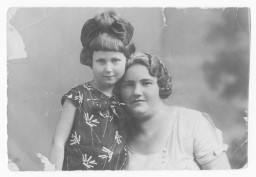
Prewar portrait of Pinchas and Roza Zygielbojm taken in 1936 in Warsaw, Poland. In 1942, they were taken into the Ponary forest outside of Vilna and killed by the SS and Lithuanian collaborators. Born in 1906, Pinchas Zygielbojm was an actor and brother of Szmul Artur Zygielbojm, a leader of the Jewish socialist Bund in interwar Poland and later a member of the National Council of the Polish Government-in-Exile in London.
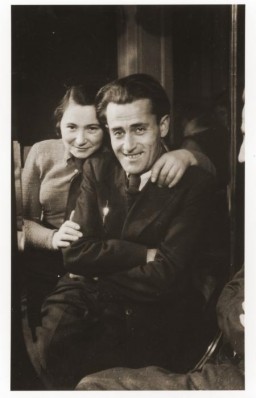
An American soldier kneels by the corpse of a prisoner on the roadside near Gardelegen. The prisoner was shot by the SS when he was too exhausted to continue on a death march. Germany, April 14-18, 1945.
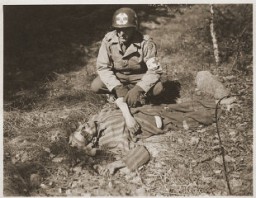
Prisoners arrested during the crackdown on leftists and other targeted groups exercise in the courtyard of the Alexanderplatz prison. Munich, Germany, April 10, 1933.

A column of prisoners arrives at the Belzec killing center. Belzec, Poland, ca. 1942. In early 1940 the Germans set up a forced-labor camp for Jewish prisoners in Belzec. The inmates were forced to build fortifications and dig anti-tank ditches along the demarcation line between Germany and Soviet-occupied Poland. The camp was closed down at the end of 1940. The following year, in November 1941, construction began on the Belzec killing center.
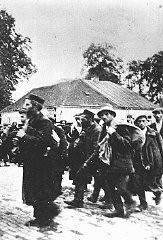
German Jews at forced labor in Dachau. Photo taken during an SS inspection. Dachau concentration camp, Germany, June 28, 1938.
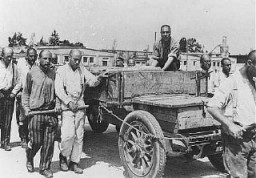
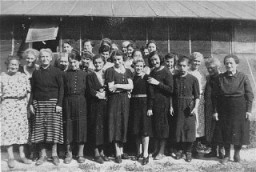
View of prisoners' barracks soon after the liberation of the Dachau concentration camp. Dachau, Germany, May 3, 1945.
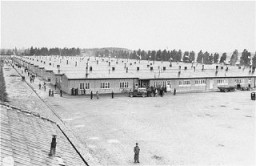
A group of women prisoners in the Plaszow camp. Plaszow, Poland, 1943-1944.
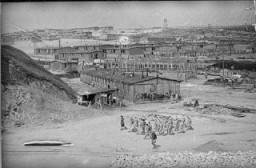
Prisoners carrying bowls in the Dachau concentration camp. Dachau, Germany, between 1933 and 1940.

Crowded living conditions: prisoners inside a barracks at Gurs detention camp. France, probably 1940.
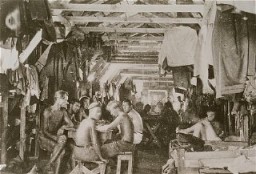
We would like to thank Crown Family Philanthropies, Abe and Ida Cooper Foundation, the Claims Conference, EVZ, and BMF for supporting the ongoing work to create content and resources for the Holocaust Encyclopedia. View the list of donor acknowledgement.